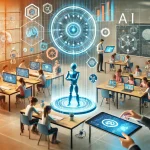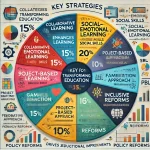In a world where artificial intelligence (AI) is transforming industries, education must adapt to stay relevant. Integrating AI into learning is more than just a trend—it’s a revolutionary shift that equips students to become the problem-solvers and innovators of the future. By empowering students with AI-driven roles, we prepare them to address complex challenges, drive innovation, and excel in a technology-centric world. This article delves into how initiatives like the EAD – AI-STEM-PBL Kids Incubator are reshaping education, the advantages of AI-powered roles, and practical strategies for their implementation.
How AI-Powered Education is Revolutionizing Modern Learning
Artificial intelligence has moved beyond being a futuristic idea—it’s now a reality that’s reshaping how we teach and learn. From adaptive learning platforms to intelligent tutoring systems, AI is making education more personalized, engaging, and effective. Picture a classroom where every student receives a customized learning experience tailored to their strengths and weaknesses. This is the transformative potential of AI.
AI tools can analyze large datasets to identify learning gaps, predict academic performance, and suggest targeted interventions. For instance, an AI system might detect that a student is struggling with geometry and provide additional exercises or resources to help them improve. This not only boosts academic achievement but also encourages a growth mindset, motivating students to take charge of their learning.
Additionally, AI is breaking down educational barriers. Students in remote or underserved areas can access high-quality resources through AI-powered platforms. Teachers, too, benefit from AI tools that automate administrative tasks, freeing up time to focus on instruction and student interaction.

Why Empowering Students with AI-Powered Roles is Essential
Empowering students with AI-powered roles goes beyond teaching them how to use AI tools—it’s about enabling them to actively engage with AI technologies, solve real-world problems, and innovate meaningfully. Here’s why this approach is crucial:
- Building Critical Thinking and Problem-Solving Skills
AI-powered roles encourage students to think critically and approach problems creatively. By working on AI-driven projects, students learn to analyze data, identify patterns, and develop solutions—skills that are essential in any career. - Preparing for the Future Workforce
The future job market will demand expertise in AI and related technologies. By introducing students to AI-powered roles early, we prepare them for high-demand careers in fields like data science, machine learning, and robotics. - Fostering Innovation and Entrepreneurship
AI-powered roles provide students with the tools to innovate and create. Whether it’s designing a chatbot, building a predictive model, or developing an AI-powered app, students can bring their ideas to life, nurturing an entrepreneurial mindset. - Encouraging Collaboration and Teamwork
AI projects often require cross-disciplinary collaboration, teaching students how to work in diverse teams and communicate effectively. These experiences mirror real-world scenarios, preparing students for collaborative work environments.
How EAD – AI-STEM-PBL Kids Incubator is Revolutionizing AI-Powered Education
The EAD – AI-STEM-PBL Kids Incubator, an innovative initiative by TechnoGroup.ai, showcases how AI-powered roles can revolutionize education. By combining STEM (Science, Technology, Engineering, and Mathematics) and PBL (Project-Based Learning) methodologies with advanced AI technologies, EAD is redefining learning for students across global curricula, including UK, Common Core, Cambridge, and IB.
Key Features of EAD: Revolutionizing AI-Powered Education
- Custom AI Learning Assistants: Tools like TeachGPT (an AI teaching assistant), GradeGenius (an automated grading system), and StudentGuide (a 24/7 learning companion) offer personalized support to students and educators.
- AI-Enhanced Learning Management Systems (LMS): These systems provide tailored learning paths, real-time progress tracking, and interactive content delivery.
- Predictive Learning Analytics: Advanced analytics identify learning patterns and predict student performance, enabling timely interventions and personalized support.
- Virtual Teaching Assistants: AI-driven assistants handle repetitive tasks, provide instant feedback, and enhance interactive learning experiences.
- Project-Based Learning: Students work on AI-driven projects that tackle real-world challenges, fostering innovation and practical problem-solving skills.
Strategies for Integrating AI-Powered Roles in Education
Integrating AI-powered roles into education requires a thoughtful approach. Here are some actionable strategies inspired by initiatives like EAD:
- Introduce AI Concepts Early
Start by teaching students basic AI concepts through interactive workshops, online courses, or hands-on projects. Platforms like Google’s Teachable Machine or IBM’s AI for Kids make learning AI engaging and accessible. - Integrate AI into the Curriculum
Incorporate AI-related topics into subjects like math, science, and computer science. For example, students can use AI to analyze data in a biology experiment or create predictive models in a math class. - Provide Access to AI Tools
Equip schools with AI tools and platforms that students can use to experiment and create. Tools like TensorFlow, Scratch, and Microsoft Azure AI are beginner-friendly and versatile. - Promote Project-Based Learning
Encourage students to work on AI-driven projects that address real-world issues. For instance, they could develop an AI app to reduce food waste or create a chatbot to support mental health. - Collaborate with Industry Experts
Partner with tech companies, universities, and AI professionals to offer students mentorship and real-world insights. Guest lectures, internships, and hackathons can bridge the gap between education and industry. - Teach Ethical AI Practices
Educate students about the ethical implications of AI, including bias, privacy, and accountability. This ensures they develop responsible AI solutions that benefit society.
How AI-Powered Education is Transforming Learning
Initiatives like EAD – AI-STEM-PBL Kids Incubator are already making a significant impact in education. For example:
- AI4ALL: This nonprofit offers summer programs that introduce high school students to AI research and applications, inspiring them to pursue careers in AI.
- Technovation Girls: A global competition that challenges girls to develop AI-powered apps to solve community problems, fostering innovation and leadership.
- Singapore’s AI Education Initiative: Singapore has integrated AI into its national curriculum, ensuring students are well-prepared for the digital economy.
These initiatives highlight the transformative potential of AI-powered roles in education, paving the way for a generation of problem-solvers and innovators.
Conclusion
Empowering students with AI-powered roles is not just about keeping up with technological advancements—it’s about shaping a brighter future. By equipping students with the skills, knowledge, and mindset to harness AI, we prepare them to tackle complex challenges, drive innovation, and lead with confidence.
Initiatives like EAD – AI-STEM-PBL Kids Incubator are leading this transformation, combining AI, STEM, and PBL to create a smarter, more adaptive learning environment. As educators, policymakers, and industry leaders, it’s our responsibility to create opportunities for students to engage with AI meaningfully. Together, we can build an education system that nurtures the problem-solvers and innovators of tomorrow, ensuring a sustainable and prosperous future for all.
By embracing AI-powered education, we are not just preparing students for the future—we are empowering them to shape it. Let’s take the first step today and unlock the limitless potential of the next generation.





